|

New find can triple number of births
Thousands of infertile couples could benefit from a new IVF procedure
that can dramatically improve the success rate of having a baby through
artificial reproduction.
Scientists believe they can double or even triple the proportion of
healthy babies born as a result fertility treatment with a relatively
simple technique that takes a series of time-lapse photographs of the
developing IVF embryos.
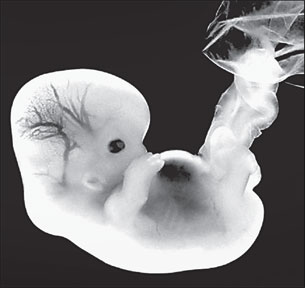 On average only about 24 percent of IVF embryos implanted into women
in the UK lead to live births but the researchers believe this could be
increased to 78 percent using the new technique for selecting the best
embryos. On average only about 24 percent of IVF embryos implanted into women
in the UK lead to live births but the researchers believe this could be
increased to 78 percent using the new technique for selecting the best
embryos.
“I believe it is the most exciting breakthrough we've had in probably
30 years,” said Professor Simon Fishel, managing director of the
Fertility Group, where the technique was developed.
“Every IVF practice in the world is unintentionally and unwittingly
putting back into the womb unviable embryos that don't make babies,”
Professor Fishel said.
“We hope to see a paradigm shift in terms of IVF. It's a game changer
for everybody to have such an uplift in live birth rates. This is the
beginning of something revelatory,” he said. Each year, licensed clinics
in Britain carry out about 60,000 IVF
treatments but most of them end in failure, causing immense emotional
upset to couples, many of whom have paid between £5,000 and £10,000 for
each treatment cycle.
The new procedure, which costs £750, identifies the best embryos to
be implanted into the womb based on the time it has taken to develop
between two key stages in the early life-cycle of the embryo.
Thousands of time-lapse pictures are taken during the first few days
of an IVF embryo's life and these are used to identify the time between
the first appearance of the fluid-filled cavity, called the blastula,
and the final moment before the embryo “hatches” from its protective
shell.
Scientists have discovered that when this period lasts longer than
about six hours, the IVF embryo is likely to be carrying an abnormal
number of chromosomes, called aneuploidy, which will lead to a failure
of the pregnancy.
A preliminary study, published in the journal Reproductive Medicine
Online and based on a retrospective analysis of 88 IVF embryos of 69
couples, found that the time-lapse technique could have improved the
success rate of life births in this particular group of patients from 39
percent to 61 percent.
Even better success rates can be expected once the procedure is
refined and applied to the wider population of infertile couples seeking
IVF treatment, Professor Fishel said.
“Our work has shown that we can easily classify embryos into low or
high risk of being chromosomally abnormal. This is important because in
itself this is the largest single cause of IVF failure and miscarriage,”
he said..
“The beauty of this technology is that the information is provided by
a non-invasive process. So far we have seen a 56 percent uplift compared
to conventional technology, giving our patients the equivalent to a 78
percent live-birth rate,” he added.
Normally, IVF embryos in an incubator are checked manually each day
by embryologists but the time-lapse cameras are able to do this
automatically by taking pictures every 10 minutes without interfering
with embryo development, said Alison Campbell, embryology director at
Care Fertility in Nottingham, who developed the computer algorithm
controlling the analysis.“With time-lapse we have the ability to view
more than 5,000 images over the same time period to observe and measure
more closely each stage of division and growth. As a result of
continuous monitoring we have demonstrated that delays at defined points
indicate abnormal development,” Ms Campbell said.
Martin Johnson, a fertility expert and editor of the journal where
the work is published, said further “prospective” studies comparing the
technique to existing methods of embryo selection are still needed
before the procedure is recommended as standard treatment. “There are
caveats with this research….and for these reasons we have to be
cautious,” he said.
Sue Avery said: “Unfortunately the study does not compare this
exciting new approach with standard practise in embryology in which
embryologists already look for the best embryos to place in the womb.
Until the new technique is compared to current practise we cannot know
whether different embryos are being chosen.”
The developing embryo goes through two key stages when the
fluid-filled cavity or “blastula” first forms and when the blastula is
fully formed before the embryo “hatches”.The time between the two is
used to judge whether the embryo is viable, with no defects in
chromosome numbers. If the period is longer than six hours, the embryo
is at high risk of abnormal chromosomes, which will inevitably lead to
complications.
Time-lapse photographs can indicate which embryos have a shorter
time-period between these two points, and so which embryos are best for
implantation into the womb.
The Independent
Mothers’ diets may harm IQs of two babies in three
Most pregnant women are deficient in iodine, a mineral vital for
cognitive development
Iodine deficiency is widespread among pregnant women in the UK and
may be harming the cognitive development of their children, scientists
have found.
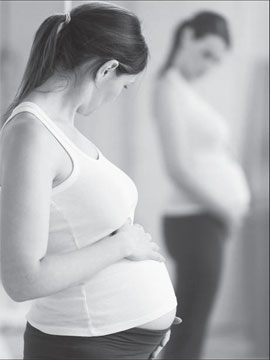 The first large study of the problem in the UK has revealed that
two-thirds of expectant mothers had a mild to moderate deficiency in the
mineral, which was associated with significantly lower IQ and reading
ability in their children at the ages of eight and nine. The first large study of the problem in the UK has revealed that
two-thirds of expectant mothers had a mild to moderate deficiency in the
mineral, which was associated with significantly lower IQ and reading
ability in their children at the ages of eight and nine.
Iodine is essential for growth and development of the brain, and
pregnant women need 50 percent more. Researchers said women should
ensure they are getting enough from their diet - milk, yogurt and fish
are the best sources - and that any pregnancy supplement they take
contains iodine.
But they warned that kelp and seaweed supplements should be avoided
as they contain variable levels of iodine and could lead to overdose.
Severe iodine deficiency is known to cause brain damage and is the
biggest cause of mental deficiency in the developing world. But mild to
moderate iodine deficiency has been little studied - until now.
Researchers from the Universities of Surrey and Bristol examined
records of 1,000 mothers who were part of the Children of the '90s study
which has followed the development of children born to 14,000 mothers in
Avon since 1990-91.
They found that 67 percent of the mothers had levels of iodine below
that recommended by the World Health Organisation. Their children were
divided into groups according to how well they performed on IQ and
reading tests at eight and nine. The results showed those whose mothers
had low iodine levels were 60 percent more likely to be in the bottom
group.
Children of mothers with low iodine scored six points lower on verbal
IQ than those born to mothers with adequate iodine. Professor Jean
Golding, founder of the Children of the '90s study, said the effect was
large enough to influence exam grades later in life. “If iodine
deficiency were rare I would not be so worried. But it is not rare. This
may prevent a child reaching their full potential.”
Margaret Rayman, professor of nutritional medicine at the University
of Surrey, who led the study said deficiency of iodine had been
widespread in the UK until the 1960s. A change in farming practice led
to iodine being added to winter cattle feed to boost milk yield in cows.
Milk then became a good source of iodine, especially in winter,
supplying 42 percent of the population’s needs and it was assumed the UK
had sufficient levels. However a Lancet study in 2011 found mild
deficiency in schoolgirls in nine parts of the UK.
“You would expect to see a deficiency in women and girls. They don’t
drink a lot of milk. Teenage girls are worried about their weight,”
Professor Rayman said.
Conventional milk contained more iodine than organic milk, and white
fish more than oily fish, she said. Recommended amounts for pregnant
women were two portions of fish a week and three portions of dairy
products a day. “If you are taking pregnancy supplements check the label
- not all contain iodine.
The recommended levels from all sources for pregnant and
breastfeeding women are 250 micrograms of iodine a day, for adults 150
micrograms and for children 90-120 micrograms.”
Pregnant and breastfeeding women, and those planning a pregnancy,
need 250 micrograms daily. The best source is fish and dairy products.
As a guide, two portions of fish a week and three portions of dairy
products a day should be sufficient. Women taking pregnancy supplements
are advised to choose ones containing iodine. The recommended amount is
140-150mcgs a day - the rest coming from diet.
It is important not to have too much - more than 600mcgs a day can
cause thyroid problems. Kelp and seaweed supplements should be avoided
as they contain excessive amounts of iodine.
- The Independent
Common foot deformities are inherited
A novel study reports that white men and women of European descent
inherit common foot disorders, such as bunions (hallux valgus) and
lesser toe deformities, including hammer or claw toe.
Previous studies show that as many as 60 percent of older adults have
foot disorders which may limit mobility and reduce their quality of
life. In fact, bunions affect 23 percent of individuals 18 to 65 years
of age and 36 percent of those over 65 years. While experts suggest that
women, older adults and those with a higher body mass index (BMI) are at
greater risk for foot disorders, there is little understanding of the
genetics involved in their development.
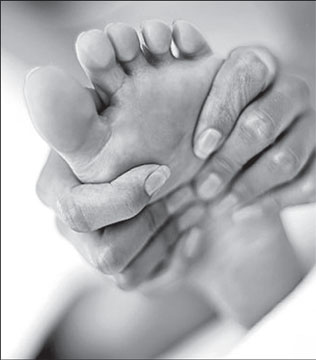 The study included 1,370 participants enrolled in the Framingham Foot
Study. The study included 1,370 participants enrolled in the Framingham Foot
Study.
Participants had a mean age of 66 years and 57 percent were female.
Foot exams to identify hallux valgus, lesser toe deformities and plantar
soft tissue atrophy were conducted between 2002 and 2008. The team
estimated heritability using software that performs genetic analyses of
familial data (pedigree structures).
Results show the prevalence of bunions, lesser toe deformities and
plantar soft tissue atrophy was 31 percent, 30 percent and 28 percent,
respectively. Hallux valgus and lesser toe deformity, two of the most
common structural foot disorders that affect up to half of older adults
in the U.S. and Europe, were found to be highly heritable depending on
age and sex.
The team reports that plantar soft tissue atrophy did not demonstrate
significant heritability in the study cohort.
“Our study is the largest investigation of the heritability of common
foot disorders in older adults, confirming that bunions and lesser toe
deformities are highly inheritable in Caucasian men and women of
European descent,” concludes Dr. Hannan.
“These new findings highlight the importance of furthering our
understanding of what causes greater susceptibility to these foot
conditions, as knowing more about the pathway may ultimately lead to
early prevention or early treatment.” - Medicalxpress
The marvel of ginger
Gourmands and foodies everywhere have long recognised ginger as a
great way to add a little peppery zing to both sweet and savoury dishes;
now, a study from researchers at Columbia University shows purified
components of the spicy root also may have properties that help asthma
patients breathe more easily.
The results of the study were presented at the American Thoracic
Society International Conference May 17-22, 2013 Philadelphia,
Pennsylvania.Asthma is characterised by bronchoconstriction, a
tightening of the bronchial tubes that carry air into and out of the
lungs.
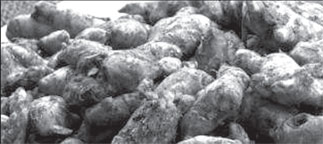 Bronchodilating medications called beta-agonists are among the most
common types of asthma medications and work by relaxing the airway
smooth muscle (ASM) tissues. This study looked at whether specific
components of ginger Bronchodilating medications called beta-agonists are among the most
common types of asthma medications and work by relaxing the airway
smooth muscle (ASM) tissues. This study looked at whether specific
components of ginger
could help enhance the relaxing effects of bronchodilators. “Asthma
has become more prevalent in recent years, but despite an improved
understanding of what causes asthma and how it develops, during the past
40 years few new treatment agents have been approved for targeting
asthma symptoms,” said lead author Elizabeth Townsend, PhD,
post-doctoral research fellow in the Columbia University Department of
Anesthesiology.
“In our study, we demonstrated that purified components of ginger can
work synergistically with â-agonists to relax ASM.”To conduct their
study, the researchers took human ASM tissue samples and caused the
samples to contract by exposing them to acetylcholine, a
neurotransmitting compound that causes bronchoconstriction.
Next, the researchers mixed the â-agonist isoproterenol with three
separate components of ginger: 6-gingerol, 8-gingerol or 6-shogaol.
Contracted tissue samples were exposed to each of these three mixtures
as well as unadulterated isoproterenol and the relaxation responses were
recorded and compared.
At the conclusion of their study, the researchers found that tissues
treated with the combination of purified ginger components and
isoproterenol exhibited significantly greater relaxation than those
treated only with isoproterenol; of the three ginger components,
6-shogaol appeared most effective in increasing the relaxing effects of
the â-agonist.
Once they were able to demonstrate that the ginger components
enhanced the relaxing effects of the â-agonist, they turned their
attention to learning why.
First, the researchers wanted to determine if the ginger components
might work by affecting an enzyme called phosphodiesterase4D (PDE4D).
- medicalxpress
New methods to manage digestive health
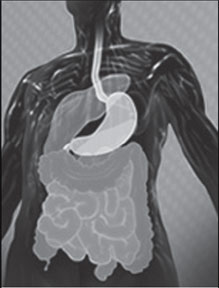 People suffering from Crohn's disease are often plagued by reduced
muscle strength, fatigue and poor quality of life. These symptoms can
remain even when patients are in remission. A randomised, double blind,
placebo-controlled study found for the first time that vitamin D
supplementation corresponded to significant relief of these symptoms. People suffering from Crohn's disease are often plagued by reduced
muscle strength, fatigue and poor quality of life. These symptoms can
remain even when patients are in remission. A randomised, double blind,
placebo-controlled study found for the first time that vitamin D
supplementation corresponded to significant relief of these symptoms.
“Our findings may have significant implications for these patients,”
said Tara Raftery, research dietician at Trinity College Dublin,
Ireland. “These findings, to our knowledge, are the first to suggest
potential benefits of vitamin D supplementation on muscle strength with
corresponding benefits for fatigue and quality of life in Crohn's
disease. These findings, however, need to be confirmed in larger
studies.”
The study found that after three months of taking 2000 IU of vitamin
D per day, patients’ muscle strength, measured by hand-grip, was
significantly higher in both dominant and non-dominant hands compared to
those taking placebo. Patients also reported significantly less general,
physical and mental fatigue and a higher quality of life when levels of
vitamin D were 75 nano mole per litre or more.
Building on growing knowledge about the human microbiome, research
from the University of Illinois, Urbana-Champaign; University of
Pittsburgh, PA; Wageningen University, the Netherlands; and the
University of KwaZulu-Natal, South Africa, features new data on
microbiota and colorectal cancer risk.
Researchers found a dramatic and rapid shift in gut microbiota after
switching the diet in healthy subjects from a traditional Western diet
to a Zulu African diet and vice-versa. The study's results show changes
in gut microbiota that might explain levels of colorectal cancer risk.
- MNT
|


